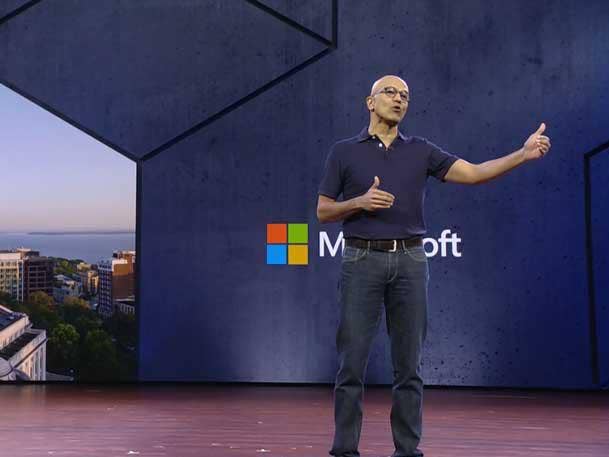Microsoft Earnings: Slow Partner Program Change Adoption Ate Into On-Premises Revenue
“We executed the change on Jan. 1, as planned, and it‘s just taking us a little longer to onboard all of this community to make sure that they can transact the way they want to in the program,” Microsoft Chief Financial Officer Amy Hood said on an earnings call Tuesday.

Despite reporting a record quarter, Microsoft’s top executives said that certain partners’ slow adoption of recent partner program changes has negatively affected the company’s on-premises Office and server businesses.
During an earnings call Tuesday for the Redmond, Wash.-based tech giant’s fiscal 2022 third quarter (ended March 31) Microsoft Chief Financial Officer Amy Hood explained that lower-than-expected Office Commercial products revenue was due in part “to the transition from our Open Licensing program to our Cloud Solution Provider Program.”
Hood said she expects to see the program transition issues continue into the current fourth quarter.
[RELATED: Microsoft Azure, Security, Teams Drive Record Quarter]
“In our on-premises server business, we expect revenue to decline in the low- to mid-single digits as demand for our hybrid offerings will be more than offset by the strong prior year comparable, which included four points of benefits – a benefit from contracts with higher in-period revenue recognition – as well as continued transactional weakness from the licensing program transition noted earlier,” she said.
When asked about the issue by an analyst on the call, Hood explained that “it‘s just taking us a little longer to onboard all of this (partner) community” to a new way of transacting.
“This really was very significant – think of it as where partners transact,” Hood said. “And we have such a broad and valuable and really-needed partner community that is very fast. And we put this and had planned for this change for Jan. 1. And we executed the change on Jan. 1, as planned, and it‘s just taking us a little longer to onboard all of this community to make sure that they can transact the way they want to in the program. So I do think it’s going to take us longer than we thought, we continue to see that impact in Q4. And I know that teams are working hard to make sure that partners get comfortable with the new system, which is important to us.”
Microsoft CEO Satya Nadella (pictured) defended the changes.
“The only thing I would add is that this change is super good for both the partners, the customers and Microsoft long term,” he said. “So (inaudible) execution ahead, but we want to do this because it benefits everybody.”
CRN has reached out to Microsoft for additional comment.
Office Commercial products are part of Microsoft’s “productivity and business processes” segment, which brought in $15.8 billion during the quarter, an increase of 17 percent year over year.
Office Commercial products and cloud services revenue grew 12 percent year over year while Office 365 Commercial revenue grew 17 percent year over year.
And despite Hood’s guidance on a continued decrease in the on-premises server business, she does expect the productivity and business processes segment to still grow next quarter, with expected revenue between $16.65 billion and $16.9 billion, she said on the call.
Open License Changes
Starting Jan. 1, Microsoft has blocked commercial customers from buying new or renewing software licenses and online services through the Microsoft Open License program, which was created more than 20 years ago to give small and midsize customers multiple, perpetual software licenses at volume price.
Partners must now steer customers with hybrid needs to buy perpetual software licenses through the Cloud Solution Provider program and licenses with Software Assurance through the Open Value program, according to Microsoft.
“These changes reflect a big step toward implementing the New Commerce Experience for our customers,” according to a Jan. 21 Microsoft Partner Center announcement on the transition.
Microsoft partners have had to adapt to multiple major partner program changes that Microsoft has implemented in a bid to simplify the partner program and streamline how customers transact with Microsoft, as company channel chief Rodney Clark recently told CRN.
One of the changes includes the reduction of 20-plus go-to-market models – including Open License, Select Plus and Web Direct – to three. The three models are a breadth motion that includes Cloud Solution Provider partners, an enterprise motion and a self-service motion.
Multiple partners have complained about some of the program changes, namely a 20 percent premium on month-to-month commitments for popular product packages including Microsoft 365 and a new partner capability score needed to achieve the status of Microsoft “solutions partner.”
Quarterly Results
Nadella still called it a record quarter, with Microsoft reporting $49.4 billion in revenue, an increase of 18 percent year over year.
Nadella credited the company’s cloud business with the growth. Microsoft Cloud revenue exceeded $23 billion, up 32 percent year over year.
“The number of $100 million-plus Azure deals more than doubled year over year, and we are seeing consumption growth across every industry, customer segment and geography,” he said.
Along with the $15.8 billion in productivity and business processes revenue, Microsoft reported $19.1 billion in its “intelligent cloud” segment, an increase of 26 percent year over year.
Azure and other cloud services revenue grew 46 percent year over year, which helped to drive server products and cloud services revenue up 29 percent year over year.
Microsoft’s “more personal computing” segment revenue was $14.5 billion, up 11 percent year over year. Windows original equipment manufacturer (OEM) revenue increased 11 percent. Windows Commercial products and cloud services revenue grew 14 percent. And Surface revenue increased 13 percent.